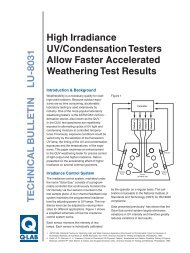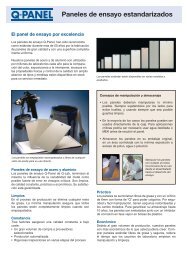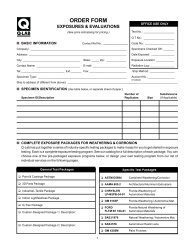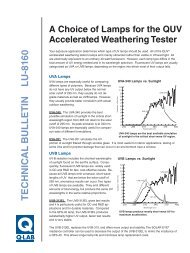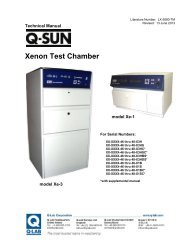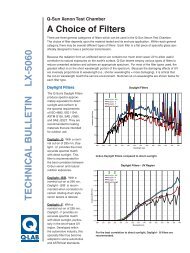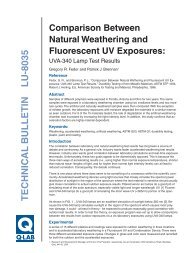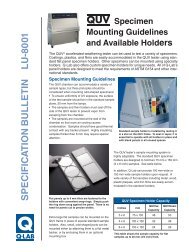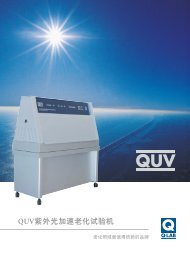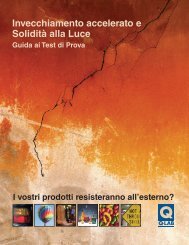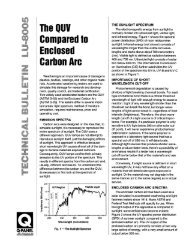Sunlight, Weathering, Light Stability - Q-Lab
Sunlight, Weathering, Light Stability - Q-Lab
Sunlight, Weathering, Light Stability - Q-Lab
You also want an ePaper? Increase the reach of your titles
YUMPU automatically turns print PDFs into web optimized ePapers that Google loves.
Two Different Approaches<br />
The QUV Accelerated <strong>Weathering</strong> Tester and the<br />
xenon arc are the most commonly used accelerated<br />
weathering and light stability testers. These<br />
testers are based on two completely different<br />
approaches.<br />
Xenon arc testers, such as the Q-SUN ® Xenon<br />
Test Chamber, reproduce the entire spectrum of<br />
sunlight including ultraviolet (UV), visible light and<br />
infrared (IR). The xenon is essentially an attempt<br />
to reproduce sunlight itself.<br />
QUV testers do not attempt to reproduce the full<br />
spectrum of sunlight, but, rather, just the damaging<br />
effects of sunlight. This is accomplished by<br />
confining the primary emission of their fluorescent<br />
lamps to the UV portion of the spectrum. This<br />
approach is effective because short wavelength<br />
UV causes almost all of the damage to durable<br />
materials exposed outdoors. Figure 6 shows the<br />
comparison between sunlight, xenon and fluorescent<br />
UV.<br />
3.0<br />
2.5<br />
Xenon with<br />
Daylight Filter<br />
Xenon Arc Lamps. The full spectrum xenon arc<br />
(ISO4892-2, ISO11341, ASTM G155, SAE J2412)<br />
allows the user to test for damage caused by<br />
short-wave UV, as well as longer wavelength damage<br />
such as fading and color change. There are<br />
two main factors to consider when using a xenon<br />
tester: effect of filters and irradiance control.<br />
Xenon Filters for Outdoor Simulations.<br />
Because the radiation from an unfiltered xenon arc<br />
contains too much short-wave UV to allow useful<br />
correlation to natural exposures on the earth’s<br />
surface, xenon testers employ various types of<br />
filters to reduce unwanted radiation and achieve<br />
an appropriate spectrum. For most of the filter<br />
types used, the greatest effect is on the short<br />
wavelength portion of the spectrum. Because the<br />
damaging effects of UV are inversely proportional<br />
to wavelength, it is critical that the cut-on wavelength<br />
match the service environment. The type<br />
of filter depends on the materials tested, and the<br />
end-use application.<br />
There are three general categories of filters that<br />
can be used in a xenon test chamber. Within each<br />
general category, there may be several different<br />
types of filters. Each filter is a piece of specialty<br />
glass designed to have a particular transmission.<br />
Irradiance (W/m 2 /nm)<br />
2.0<br />
1.5<br />
1.0<br />
0.5<br />
QUV with<br />
UVA-340 Lamps<br />
<strong>Sunlight</strong><br />
0.0<br />
250 350 450 550 650 750 850 950 1050<br />
Wavelength (nm)<br />
Figure 6- <strong>Sunlight</strong>, Xenon and Fluorescent UV<br />
Daylight Filters produce spectra approximately<br />
equivalent to direct, noon summer sunlight and<br />
conform to the spectral requirements of ISO 4892,<br />
ISO 11341, ASTM G155, SAE J1960 and SAE<br />
J2527. They are recommended for testing materials<br />
that are intended for outdoor use and allow<br />
the best correlation between xenon and natural<br />
outdoor exposures. See Figure 7 and Figure 7A.<br />
In addition to the technical considerations, there<br />
are practical ramifications to these differing approaches.<br />
Xenon testers require a lot of electrical<br />
input to produce their full spectrum. Consequently,<br />
they also generate a lot of heat from the visible<br />
and IR portions of the spectrum. This heat must<br />
be removed by either a water-cooling or an aircooling<br />
system. Therefore, differences in the operating<br />
costs of the two tester types are significant.<br />
For a full discussion, see Q-<strong>Lab</strong> Technical Bulletin<br />
LU-8009, QUV & Q-SUN: A Comparison of Two<br />
Effective Approaches To Accelerated <strong>Weathering</strong> &<br />
<strong>Light</strong> <strong>Stability</strong> Testing.<br />
Irradiance (W/m 2 /nm)<br />
2.0<br />
1.5<br />
1.0<br />
0.5<br />
<strong>Sunlight</strong><br />
Xenon<br />
Extended UV<br />
0.0<br />
250 300 350 400 450 500 550 600 650 700<br />
Wavelength (nm)<br />
Figure 7- Xenon with Extended UV Filters<br />
4



